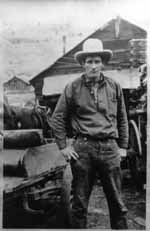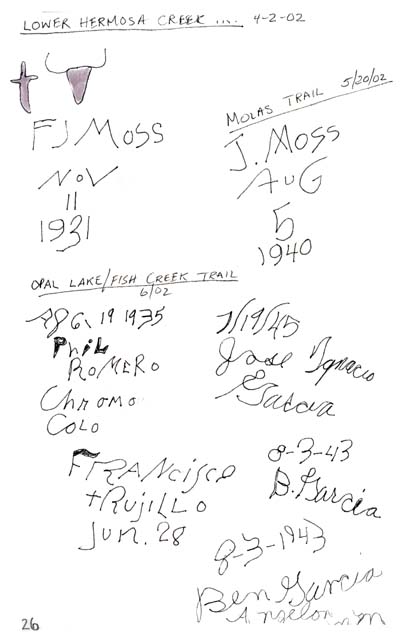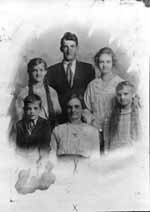Collection D 002.05:
|
Esther Greenfield's arborglyph documentation interests led her into a study of individuals whose names she found carved on aspen trees -- most notably, Frank J. Moss. This unfolded into quite the string of discoveries, both in the archives and as a result of the local newspaper's publicity of her work. Below this image is the text of two articles she wrote, which were published in the Durango Herald on November 26, 2006 and January 28, 2007, and which Ms. Greenfield has graciously agreed to include on this web page for the benefit of researchers.
|
|
|
© 2006
Center of Southwest Studies,
Fort Lewis College.
All rights reserved.
|
By Esther Greenfield Special to the Herald (published in the 11/26/2006 issue)
The lines and curves of his name swirl around the aspen tree bark revealing a flair for the dramatic and a sense of humor, too. Over his name, F. J. MOSS, he draws a steer with horns and a cartoon-like cowboy hat.
It scrolls through familiar names, like the PENNINGTON family, William and Rosa, their daughter Thelma and son James. And then through the BODO family, Louis and Frances ("wife and homemaker"), the McDANIELS and the BANDINOS. In the BANDINO records I note that the father, Antonio, and a boarder also named Antonio, have come here from Italy. Both are coal miners.
| Frank Moss with his siblings and their mother, circa 1920/1925. Frank Moss is standing in rear. To his left: sister Bernice. To her left: sister Dorothy Thomas. In front of Moss: mother Amy Moss Cooper. To Moss's right: sister Mildred Moss. In front of her: brother Rhae (Ray) LeRoy. Photo courtesy of Mary Ann and Jakie Moss. |
"Well," I think, sitting back in my chair, well satisfied. "These are the bare bones of a life, but what of the man?" What were his hopes and dreams, did he have laugh lines around his eyes? Was he a baseball fan? Did he fight in WW I? Did he and Vera prosper and have children? Perhaps I'll never know, but now when I hike and am lucky enough to find some evidence of him in the trees I will smile as though he were an old friend. Which, by now, he is.
A bittersweet ending: Arborglyph story
on F. J. Moss leads to rest of the tale
By Esther Greenfield Special to the Herald (published in the 1/28/2007 issue)
 |
| F.J. Moss, a cowboy called as handsome as the "Marlboro Man" by some, poses for a photo in the 1930s or '40s. Photo courtesy of Mary Ann and Jakie Moss. |
With a reluctant murmur, the ghosts in Frank
Moss's life sigh and blow away the last wispy remains of the fantasies I'd
had about this man whose name I'd found carved into aspens all around the
Hermosa and Cascade creek areas. What remains is as close to reality as is
possible after more than 63 years of secrets.
| Children stand in front of what they called the school bus in Rockwood in 1922. Mary (Lechner) Moss is the little girl on the far left. The driver of the bus is her mother, Annie Lechner, and she is the partially hidden figure to Mary's left. Later, Mary would drive that bus. Photo courtesy of Dorothy Lechner. |
Still, those good looks and the charm he could turn on when he wanted to attracted the attention and love of a pretty, sweet 18-year-old girl named Mary Lechner, who would become his first wife in 1934. She was one of several children born to Anthony and Annie Boyce Lechner, who had a ranch in the Rockwood area. Quiet and soft-spoken, Mary Lechner nevertheless had lots of spunk. Friends remember her driving the Rockwood "school bus" - really just a wagon covered with canvas - filled with children. Although the road to the school was narrow and difficult, Mary handled the team of horses (named Snookie and Nellie) with a skill far greater than one would imagine for a girl so young.
Relatives remember a story that Mary liked to tell. "'I was maybe 10 years old,' she'd say, 'on my horse rounding up some cattle on top of the Hermosa Cliffs when a bull charged off out of the herd.'" With Mary close behind, yelling, the unlucky bull ran right over the edge of the cliff and fell to his death. Mary was just able to pull her horse to a stop before she, too, went over the cliff. "She was truly a frontier girl," says a relative.
Mary's spunkiness undoubtedly helped her survive the five turbulent years she would be married to Frank Moss. Despite living desperately poor in a "thrown-up shack"; a cave-like place with boards nailed up in front for a wall, she tried to make a good home. Their first child, a little girl, lived only a short time. Other children soon followed, a son and then a daughter, but Mary's life with Frank was anything but idyllic. His rages continued and Mary reached the point where she knew she could no longer continue to live with him. One night, while Frank slept, she grabbed a gunny sack and tossed in some food and clothing. Then, carrying her baby daughter and leading her 4-year-old son by the hand, she took the children and left. It was dark and it was snowing as the three of them walked miles to safety at a cousin's house in Durango. "It's a wonder they all didn't freeze to death," says a relative. She never returned to Frank, and later they were divorced.
 |
|
A view of the Rockwood (Colo.) train depot, 1925, with the depot's outhouse in the foreground. Photo courtesy of Dorothy Lechner. |
"This is not what I imagined when I looked at the F J MOSS aspen tree carvings," I think to myself as I sit back and mull over these revelations. I begin to see that life on the range - before there were women's shelters, support groups, Dr. Phil or telephones - made for some very tough and resilient people. People who would have just suffered quietly because in those days no one discussed what went on between husbands and wives, particularly when it was so hurtful.
Mary moved on with her life. She married Calvin Grimmett, and had two more children. She worked very hard, like most farm wives, tending the animals, keeping house and cooking. Her children fondly remember how after a "tasty dinner" she and Calvin would stand together at the sink talking, laughing and doing the dishes. Her family believes that it is her story, one of survival, courage and frontier life, that needs to be told, not Frank's. Well-loved, with many friends, Mary died in 2002 at age 88, a "very old and very happy lady."
The end for Frank Moss was not so happy. By the early 1940s his second marriage, to Vera Meadows, was not going well and he was living alone at the L.J. Randleman ranch where he worked. To earn extra money, Frank was also working in a mine in the Coal Gulch area near Lightner Creek. One morning, with a great roar, the ceiling of the mine collapsed, crushing his leg. It never healed properly and he eventually had to have it amputated.
When he returned to the Randleman ranch he was on crutches. His life was in shambles. Vera (who is still alive and currently living in Washington state) was about to leave him. He had only one good leg and he could no longer ride a horse. Although the cowboy way of life was already just beginning to pass over the horizon, it was the only life he knew or loved.
Despite repeated warnings from his doctor to rest, on the evening of Friday, April 2, 1943, Frank got his crutches and stumbled up to a field to check on some cattle. On his way back disaster struck in the form of a pulmonary embolism. He died under a large piñon tree, his crutches flung out at his side. He was only 43 years old. He was buried in the family plot in Marvel on April 6, 1943. His obituary refers to him as a well-known and respected stockman.
So, that is the rest, and the end, of the story of Frank Moss as I know it. I am sure that no amount of searching for a few carved words on some aspen trees could ever have revealed this story without the encouragement of those friends and relatives who wanted it to be told. And now that it is told, I will look no more for signs of this troubled man in the shadows and light of the aspen groves.
Special thanks to K.C. Robertson, and to Mary Ann and Jakie Moss, Dorothy Lechner , Harold Wilson, and Kurt Hutchin for their help. Reach Esther Greenfield at estgreen@sisna.com.
Page revised: 2/19/2007



